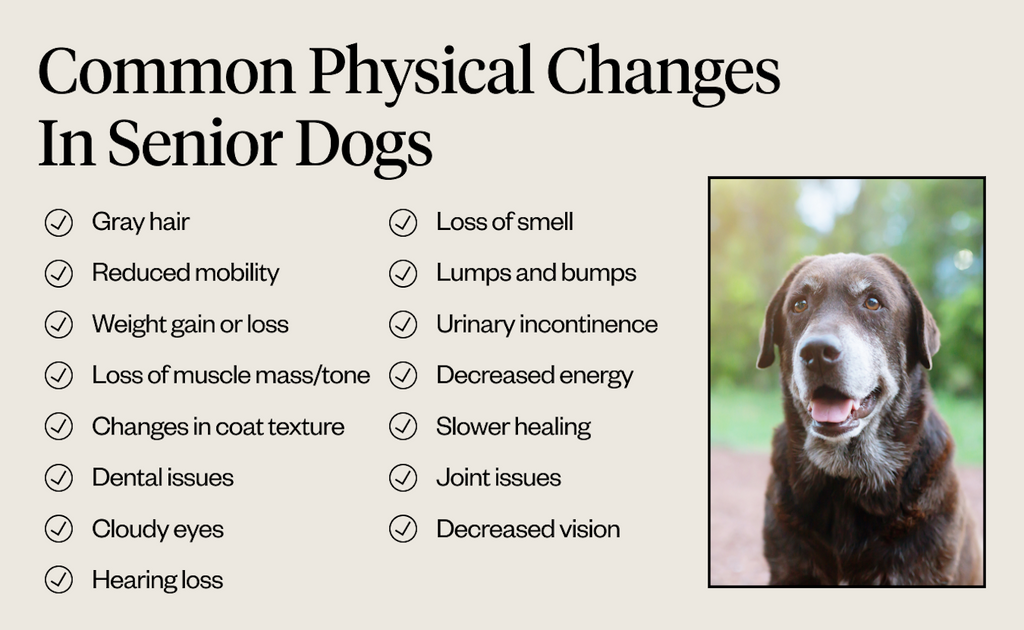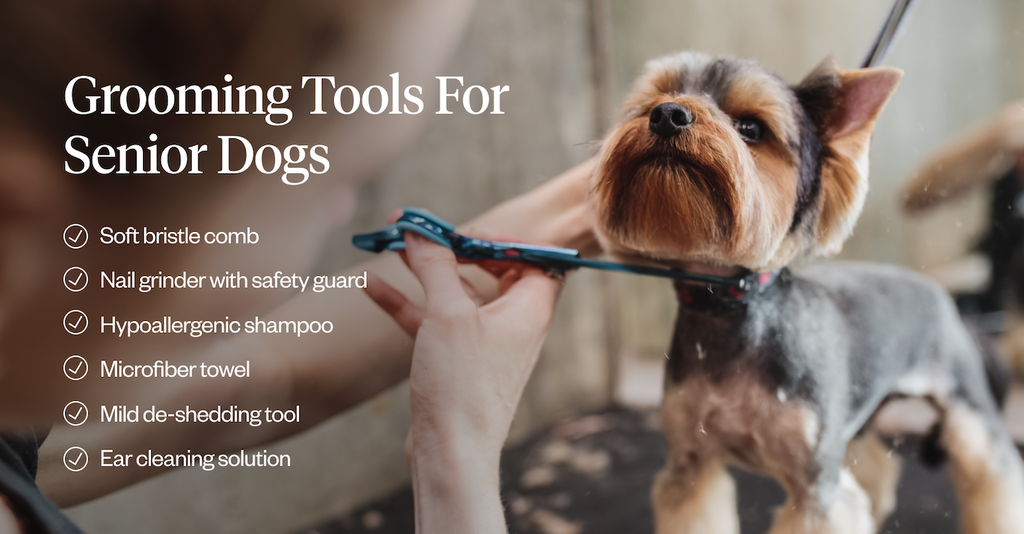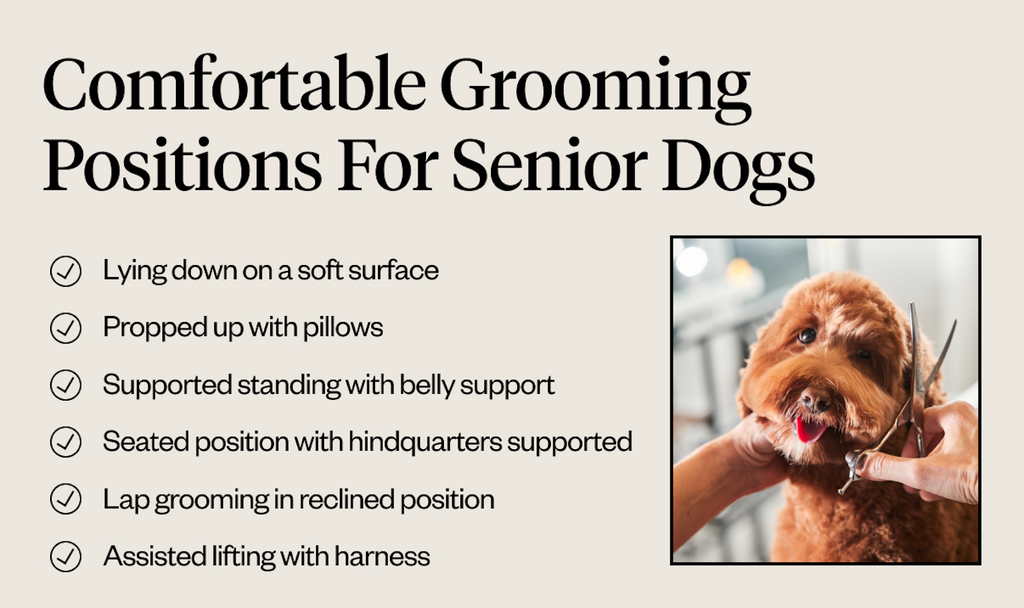11 Min Read
Grooming Senior Dogs: Tips & Safety
Key takeaway
As your pup enters their golden years, grooming becomes different. While keeping them clean and looking good, you also have to closely monitor their health and make sure they are comfortable during the grooming process.

Why pet owners are switching to online vet care with Dutch
-
Prescriptions delivered free to you
-
Fast access to Licensed Vets over video
-
Unlimited video visits and follow-ups
Grooming is an essential part of caring for your dog, especially as they get older. As your dog enters their golden years, their grooming needs will change and may require an entirely different approach than what you’re used to. Grooming senior dogs can require more attention and patience, but the importance of grooming remains the same.
Is your dog in their senior years? Generally, depending on their size, you can consider a dog a senior when they reach about 6 to 11 years of age.1 This isn’t a hard and fast rule, but can give you a general idea of whether your dog has become a senior pup.
Here is a look at dog grooming for senior dogs, why it’s important, and essential tips for facilitating the process to help your senior dog age with health and grace.
- Physical Changes In Senior Dogs
- The Importance Of Grooming Your Senior Dog
- Essential Grooming Tips For Senior Dogs
- Safety Measures During Senior Dog Grooming
- Professional Grooming Vs. At-Home Grooming For Senior Dogs
- Final Notes
Physical Changes In Senior Dogs

Aging comes with many physical changes that impact grooming needs and techniques. These changes often have a significant impact on appearance, health, and behavior. Here are some of the more common changes to stay cognizant of with old dog grooming:
- Coat and skin changes: Coat texture and color can also change with age. Senior dogs may have thinner, drier, flakier, or duller coats. Their coats often thin out or lose hair unevenly, and show slower hair regrowth. You may notice more shedding, matting, or tangles in their fur.
- Muscle mass and mobility: Senior dogs may lose muscle mass and strength as they age, which can affect their mobility and balance. They may also develop arthritis or other joint problems that cause pain, stiffness, or inflammation in their joints. Loss of muscle mass and tone leads to difficulty standing up, laying down, and reduced mobility overall.
- Weight changes: Senior dogs may gain or lose weight as they age, depending on their metabolism, activity level, diet, and health conditions. Weight gain can increase the risk of obesity-related diseases. Lower activity levels mean slower metabolism and potential weight gain. Dental issues, decreased appetite, or illness can cause weight loss.
- Dental changes: Senior dogs may have more dental problems, such as plaque, tartar, gum disease, tooth decay, or tooth loss. These can affect their oral hygiene, chewing ability, appetite, and overall health.
- Eyesight and hearing changes: Vision and hearing often diminishes in senior dogs, sometimes quite significantly. These issues can affect their perception of their surroundings and their responsiveness to commands or cues. They may also develop eye diseases such as cataracts or glaucoma that impair their eyesight.
- Energy level changes: Senior dogs will likely nap and sleep more, or become less active in general. They want more rest and comfort, and may tire easily from even the activities they enjoy most.
- Joint and bone changes: Senior dogs may have weaker bones and joints than younger dogs, which can increase the risk of fractures or injuries. They may also develop osteoporosis or osteoarthritis that affect their bone density and joint function.
- Cognitive changes: Some senior dogs may experience cognitive decline or dysfunction as they age. This cognitive decline can affect their memory, learning ability, attention span, and behavior.1
The Importance Of Grooming Your Senior Dog
Grooming only grows more important as your dog ages. Here are some of the things regular grooming helps with:
- Coat and skin health: Brushing removes dirt, dead skin cells, excess oil, and loose hair that can cause matting, tangles, or skin irritation. It can also stimulate blood circulation, distribute natural oils, and improve the appearance and texture of their coat. Bathing with appropriate shampoos can cleanse skin, remove odors, and prevent infections.
- Mobility and comfort: Trimming can reduce weight and bulk of fur, which can improve mobility and comfort. It can also prevent overheating and keep them cooler, especially after summer haircuts. Trimming the hair around their eyes, ears, mouth, and paws can also improve their visibility, hearing, breathing, and walking. Preventing matts reduces pulling on skin in friction areas.
- Temperature regulation: Grooming helps senior dogs adjust to different weather conditions by keeping them warm in winter and cool in summer. A clean coat allows for better heat dissipation during hot weather and better insulation during cold weather.
- Ear and eye health: Cleaning the ears and eyes of senior dogs prevents the buildup of wax, dirt, or debris that can cause infections, irritation, or inflammation. It can also help you detect any signs of ear or eye problems such as redness, swelling, discharge, or odor.
- Dental health: Brushing your senior dog’s teeth can prevent plaque, tartar, and bacteria that can cause gum disease, tooth decay, or tooth loss. Grooming routines often involve teeth brushing, which helps maintain oral hygiene and prevents dental problems that can impact overall health.
- Nail care: Nail care for senior dogs prevents nails from growing too long and causing pain, injury, or infection. Long nails can also affect your senior dog’s posture and gait and increase the risk of arthritis or joint problems.
- Serves as a wellness checkup: Grooming allows you to monitor their physical condition and notice any changes or abnormalities. You can also feel for any lumps, bumps, or growths that may indicate tumors or cysts. If you find anything unusual or concerning, consult your veterinarian.
- Bonding with their owners: Positive physical contact during grooming strengthens the bond between a senior dog and their owner. It can also reduce their stress and anxiety and improve their mood and behavior.
Essential Grooming Tips For Senior Dogs
Grooming for elderly dogs requires some adjustments. In some cases, you may have no previous practice with grooming, for example, if you’re trying to figure things out after adopting a senior dog.
Here are some essential grooming tips for senior dogs:
Brushing And Coat Care

Choose the right brushes and combs for your senior dog’s coat type and length. Use soft bristle brushes to avoid irritating thinning or sensitive skin. Frequency of brushing will depend on their coat condition, but try to brush as often as needed. Start from the head and work your way down to the tail, brushing in the direction of hair growth with gentle strokes.
Do not try to force or cut through mats and tangles, as this can hurt or injure your dog. Instead, use your fingers, a mat splitter, a dematting comb, or scissors to gently separate or cut out the mats or tangles. If the mats or tangles are too severe or close to the skin, consult a professional groomer or veterinarian.
Bathing And Skin Care
When figuring out how to bathe your dog, you can follow these tips. Use appropriate shampoos for your senior dog’s coat and skin type. If you wonder whether you can use human shampoo, the answer is an emphatic no. Use mild, gentle, moisturizing, hypoallergenic, or medicated shampoos specially formulated for dogs.
You can also ask your veterinarian for recommendations as well as for advice on how often you should bathe your dog.
Maintain proper water temperature when bathing your senior dog. Use lukewarm water.
Gently pat them dry with a soft towel. Do not rub or scrub their fur. You can also use a hair dryer on a low or cool setting. Keep the hair dryer at a safe distance and move it around constantly.
Nail Trimming
Use a nail clipper or a nail grinder suitable for their nail size and type. Cut small amounts at a time to avoid hitting the quick, which is the blood vessel inside the nail. Grind the nail in short bursts until you reach the desired length. You can also use a nail file to smooth out any rough edges.
For overgrown nails, trim them more frequently and gradually until they reach the proper length. You can also consult your veterinarian or a professional groomer for advice on how to trim overgrown nails safely and effectively.
Ear Cleaning
Use an ear cleaner suitable for dogs. Follow the directions of the cleaning solutions closely. Massage the base of your dog’s ear for a few seconds to loosen up any dirt or wax. Then, use a cotton ball, a gauze pad, or a soft cloth to gently wipe away any excess cleaner and debris from their ear flap and opening.
Do not insert anything into their ear canal, as this can hurt or injure them.
While cleaning your senior dog’s ears, check for signs of ear problems such as redness, swelling, discharge, odor, itching, pain, or head shaking. If you notice any of these signs, you should consult a veterinarian.
Dental Care
Use a soft-bristled toothbrush and a dog-friendly toothpaste suitable for their age and size. Do not use human toothpaste. Brush their teeth in circular motions, focusing on the outer surfaces. Do not force their mouth open or brush too hard.
Brush your senior dog’s teeth regularly and reward them to make it a positive experience.
Some special considerations for dental care of older dogs:
- Your older dog can have more sensitive or painful teeth and gums.
- You can use smaller toothbrushes and toothpastes specially designed for senior dogs.
- You will need more gentleness and more patience than normal.
Safety Measures During Senior Dog Grooming
Take safety measures during senior dog grooming to ensure their comfort, well-being, and protection:
Environmental Accommodations
Provide non-slip surfaces for your senior dog during grooming. These can include rubber mats, towels, or carpets. Provide a comfortable grooming area for your senior dog. This can reduce their stress and anxiety and make them feel more relaxed and secure.
Allow your dog to lay down or sit during grooming to reduce strain on joints. Use blankets, orthopedic beds and pillows, padded surfaces, or cushions for extra comfort and support.
Handling And Restraint

Use gentle handling techniques for your senior dog during grooming. Employ slow, calm, and soothing movements and commands. Give breaks as needed and always stay alert for signs of pain or distress.
If necessary, use minimal restraint during grooming, such as a leash, a collar, or a harness. However, do not use too much force or pressure when restraining your senior dog.
Monitoring Your Senior Dog’s Well-Being
Keep an eye on changes in behavior or condition during grooming. These could indicate your senior dog has stress, anxiety, fear, or a general unwell feeling. If you notice any of these signs, stop grooming and comfort your dog. Consult your veterinarian if the signs persist or worsen.
Professional Grooming Vs. At-Home Grooming For Senior Dogs
Both options have their pros and cons, and you should weigh them carefully:
Pros of Professional Grooming for Senior Dogs
- Skills, experience, and equipment to groom senior dogs safely and effectively.
- Specialized grooming services for your senior dog.
- Saves time and effort.
- Access to specialized tools and equipment.
Cons of Professional Grooming for Senior Dogs
- Expensive, especially if your senior dog requires frequent or extensive grooming services, along with potential expenses for transportation, special requests, or emergencies.
- Can stress or traumatize your senior dog if they are not used to it or have anxiety from long wait times, unfamiliar environments, loud noises, strange smells, etc.
- Scheduling appointments can become a hassle.
Pros of At-Home Grooming for Senior Dogs
- Cheaper, as you only have to buy the basic grooming tools and products you need.
- More comfortable and relaxing for your senior dog, as they can stay in their familiar surroundings.
- More control and flexibility in grooming your senior dog.
- Easier to notice subtle physical or behavioral changes.
- Increased opportunities for bonding.
Cons of At-Home Grooming for Senior Dogs
- Challenging and time-consuming.
- The mess, hassle, or frustration of grooming at home.
- You can miss signs or symptoms of health problems a professional groomer may notice.
- Possible difficulties handling or restraining your senior dog.
- You can hurt or injure your senior dog, or your dog can hurt or injure you if grooming goes wrong.
If you're unsure how to groom a senior dog safely or if they require specialized care, do research to find an experienced groomer familiar with handling senior dogs. Provide details on your dog's condition beforehand. They can provide guidance and ensure your dog receives proper care.

Final Notes
Regular grooming for elderly dogs enhances comfort, mobility, and quality of life for senior dogs. With some planning and minor adaptations, you and your senior dog can continue enjoying the bonding benefits of regular grooming. Always prioritize their well-being and safety, and seek veterinary care if you have any concerns.
If you need any help or guidance in grooming your senior dog, try Dutch, a veterinary telehealth service that connects you with licensed veterinarians online. You can chat, call, or video consult with a vet anytime, anywhere, and get personalized advice and recommendations for your senior dog’s grooming needs. You can also get prescriptions, refills, or supplements delivered to your door.Share
References
-
"Caring for senior cats and dogs." American Veterinary Medical Association. https://www.avma.org/resources-tools/pet-owners/petcare/senior-pets.



